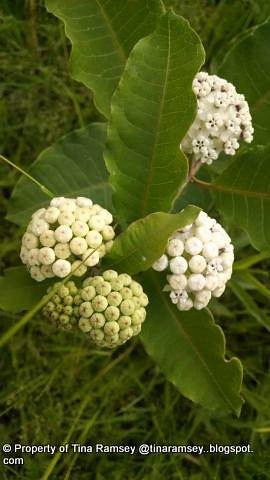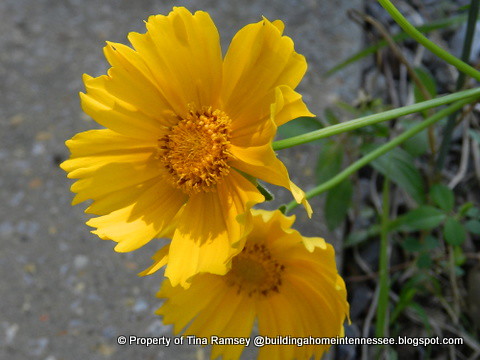
Today's post is really about pawpaw tree shelters but I could not resist putting in a few pictures of flowers on the land. A lot of these flowers are new to me and if you follow this blog regularly, you will know I am enamored of native wildflowers. We have a lot on the land and nurturing them while keeping the forest at bay has been a delicate balancing act for me. Last year the above white milkweed (Asclepias variegata) was bushogged down just prior to blooming. All this time I actually thought this milkweed was common milkweed. I was delighted when it bloomed to finally identify it as white milkweed, aka redring milkweed after initially misidentifying it as whorled milkweed. This plant is really nothing like whorled milkweed other than the color of the bloom being white. Can you see why it is sometimes called redring milkweed? The red rim around the center of the flowers as shown in the fully opened flower on the above picture is where this common name comes from. This milkweed is a milkweed of open forest area and is not usually found in great quantities so the butterflies sometimes don't find it. When they do, however, there is a lot of nectar for them and the bees. This is a native milkweed that likes rocky, dry, mesic soils. This is exactly what this plant and a few other close by ones get on the farm on the back 40 I affectionately call 'Wildflower Hill'. My little group grows on an east facing slope under a dogwood and oak tree. They are in a perfect spot for viewing and that is just what I do.

We also have some native coreopsis blooming on the farm and boy oh boy is it ever pretty. Not only do the flowers look great but the buds are quite large and distinctive. I believe this native coreopsis to be Lanceleaf coreopsis (Coreopsis lanceolata). If I am wrong please let me know. Like I said, wildflowers are new to me and it has been a steep learning curve since I really don't actively cultivate many wildflowers in my garden. This one is not a flower I planted, but I have allowed it to grow near the gazebo in a somewhat wild area of the new garden.

Now this little beauty is one flower I did plant on the farm into the new Crabapple Garden (post coming next Monday). I was thrilled to see it still continued to grow and bloom despite being dug up and moved. Clematis is one of those easy plants to move that does not overly resent disturbance. I have moved several plants that do resent disturbance. At some point I need to prepare a post on my experiences with moving plants. I've moved thousands now which include: trees, shrubs, bulbs, perennials, grasses, vines, and annuals. Some of the plants have really amazed me with their resilience, while others have really shocked me when at first they seem to be doing well but then they die. This mainly happened to shrubs I moved last fall that were not quite ready for our winter. I tell you one key thing with being successful with moving any plant is to time it right. You can move a hydrangea successfully in spring and early summer but if you wait until late summer or fall don't expect it to make it through the winter. Azaleas, camellias, and a few other plants are like this too. For the most part I try to tailor my move times to the specific plant. There is no one size fits all but clematis can be moved pretty much anytime.

The primary purpose of this post is to talk about tree shelters. I ordered three pawpaw 'trees' last fall from Hidden Springs Nursery in Tennessee. Hidden Springs was one of the nurseries recommended by Kentucky State University's Pawpaw program. I must say I have been delighted with the results! When the little whips arrived last November they looked pretty pitiful. I had little hope they would do well but the one way I could tell they were alive was pretty foolproof for me. Just scratch the bark a bit and look for green. All of mine had green so I planted them as instructed and hoped for the best.
I had done a lot of research prior to ordering my orchard plants and these new pawpaws were scheduled to go into the orchard. The instructions for planting and the research I found online said to cover the pawpaw seedlings for the first year or two or three to protect them from the sun. It seems pawpaw seedlings do not do well in full sun while young, but once they are mature they will prosper just fine in full sun. This is the reason you see most pawpaw groves in the shade.
Finding our very own pawpaw grove on our land was a goal of ours and while we hunted very hard for one last year we could not find one. Hence the pawpaw whips purchased for the orchard. Finally this year was the ticket to find a pawpaw grove on our land! The area the grove is in is not only partly shaded, but it is a low area prone to wet periods. which will help with cross pollination of these new cultivated pawpaws. The wild pawpaws do not need any tree shelters but are in a location that will perhaps help out with cross pollination of our cultivated pawpaw seedlings.
Back to our pawpaw seedlings and how to cover them to protect them from the direct sun. I could not quite figure out how to cover them. It was recommended from several websites to use 'tree shelters'. I am not quite sure what tree shelters might be, and it is pretty hard to buy tree shelters so I created my own. Can you see the bur-lapped boxes in the above picture? Those are my three tree shelters covering my pawpaws (KSU, Overleese, and Sunflower).
The shelters look really weird and seem out of place in the orchard but are vitally necessary. I made my shelters from some old pepper cages I had on hand and covered them with burlap I had saved from other plants. The burlap allows rain and some filtered light to get to the plants but protects the plants from the direct rays of the sun. I hoped the shelters would work to aid the pawpaw seedlings but I had no idea if the pawpaws even made it through the winter since pawpaws leaf out late. I really have not had the time to check on the pawpaws until recently. Looking in those shelters just was not a priority for me but Mr. Fix-it peeked under the cover and look what he discovered!

The pawpaw seedlings are doing quite well. All three have leafed out and have put on a lot of growth since the growing season started. While it appears this one is being chomped by some pest, I have not had the time to investigate what it could be or how to treat it. I was just excited to see that the pawpaws leafed out and are doing fantastically. This is more than what I can say about some of my orchard trees that were planted as whips the same time as these pawpaws. Every one of the whips (14 total) have leafed out but some have leafed out better than others. I'll prepare a post on the orchard one day. The orchard has been a dream of my husband's because he believes in growing his own food. Of course in our case I do the growing; he does the picking. Me on the other hand, I know how difficult growing fruit trees can be so I was not as enthused with the orchard idea though it has been a fun experience. I think once the fruits start coming in we'll really be having fun. This year we will only be picking muscadine grapes and blueberries but hey, it's a start. And for now those pawpaw seedlings are looking great and I look forward to picking some fruit from them in a few years. I think by next year I will have to raise the height of the tree shelter to accommodate the growth of the pawpaw seedlings but for now I must say the pawpaw experiment has been an awesome time....
in the garden....
On today's Memorial Day I think of all the brave men and women who have fought for our freedom, but mostly I think of those in my family who have paid the ultimate sacrifice to ensure our country stays free. Take a moment today to give thanks, if only silently, for all you have in life. I will be doing the same...in the garden...
I made a mistake when I watermarked all of the photos on this post and several more that will be posted this week. I forgot to change the url to the correct one for this blog. Rather than remove these, reload the correct ones, and re-tag everything I have decided to leave them as they are. It is not like the watermark really stops folks from lifting photos anyhow as I have so often found but in case you, loyal reader and never a person who lifts the photographs from here, was wondering now you know why. That url on these is one that leads to my private blog about my home build. I will not be sharing that publicly with anyone but did watermark the photos.




















